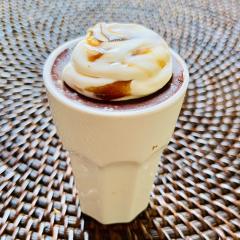-
Posts
8,085 -
Joined
-
Last visited
-
There's a "mayo season"?
-
For some reason this myth persists. Unless you're using homemade mayo made with raw, unpasteurized eggs, mayo is perfectly safe, and may actually prevent foodborne illness. Supporting documentation: the USDA, among others. GIYF.
-
Close. I'm pretty sure it's one of these. ETA: confirmed. Trigger pulled here.
-
We had a bottle of this last night with a creamy mushroom soup (really unpleasant to look at, but tasty nonetheless). According to the distributor, this should not be a great match They suggest that heartier dishes like steak and beef casseroles (whatever those are) are good accompaniments. We were very happy to pair it with the soup. As for that Kono sauvignon blanc: at a recent wine tasting, I made our host (a sommelier from a local restaurant) very angry when I pointed out that the Kono we were sampling was available at TJs for nine bucks. The event organizers sell the wines we taste, and the Kono was listed at $21. Making my announcement sent several fellow tasters to their phones to check the TJ site. Turns out whatever deal TJ's made did not include Atlanta, because three stores near us don't have it. But Total Wine has it for $13.
-
I do believe it. It's a step up from the fried bologna sandwiches I made when I was a kid.
-
Having lived in the south for 55+ years, I knew most of this. But for someone wanting a balanced introduction to barbecue, this is an excellent article. (I admit to never having heard about the Memphis infatuation with smoked bologna, though.)
-
Toby himself flagged Eliot (and that passage), but he also invoked Bernard De Voto: Link here.
-
What is that based on? Potatoes are not especially moist -- 80% is not high relative to fruits and vegetables like greens. Consulting the Michigan State University Extension, we find that "Potatoes, sweet potatoes, onions and dry garlic prefer cool, dry conditions . . . (t)hey actually don’t need to be refrigerated at all.
-

David Leite's essay on preparing clam chowder
Dave the Cook replied to a topic in Food Traditions & Culture
I recommend his blog. It's not just funny; it's also informative. But there's more right her on eG. Waaaaay back in 2003, David -- already an established writer -- contributed a short course to the eG Culinary Institute on food writing. That, and the associated Q&A are both well worth perusing.- 1 reply
-
- 1
-

-
Sweet! I don't have one, but I've had my eye on it for a while. I'm really interested in your experiences with it.
-
I am sure I won't be alone in nominating TJ's Unexpected Cheddar as a go-to for several of us.
-
Bread pudding is, traditionally, a sweet dish. However, savory versions do exist. In our collection, I found: Spinach-shiitake bread pudding Bread Pudding With Artichokes, Cheddar and Scallions Mushroom Bread Pudding and then, just to throw another wrench in the works, I stumbled across Croque Monsieur Strata Strata with Spinach and Gruyère Strata With Mushrooms and Chard That last recipe, which I got from the New York Times, includes a paraphrase from Martha Rose Shulman where she calls strata "savory bread puddings." So I suppose that often the difference is often just the vessel in which the dish is prepared? I'm not sure what is meant by "homogenized" here, but it's essentially what I thought. I kind of still do. Yes. Every recipe I listed above, as well as every other recipe I came across, at a minimum called for three things: bread, eggs and dairy. The last two create a custard that is used to moisten the (usually stale or dried) bread and make it adhere to itself. Sometimes wine and/or stock is included.
-
I'm impressed with your fortitude and your inventiveness. What's the difference, if any, between a panade and a bread pudding?
-
Your voyages are exciting and inspiring. It's heartening to know that there will be a next time.
-
Seriously? The LCBO is ripping you off in a more offensive manner than usual. https://www.totalwine.com/wine/white-wine/pinot-grigio-pinot-gris/c/000052?&pageSize=24&aty=1,0,0,1&instock=1














